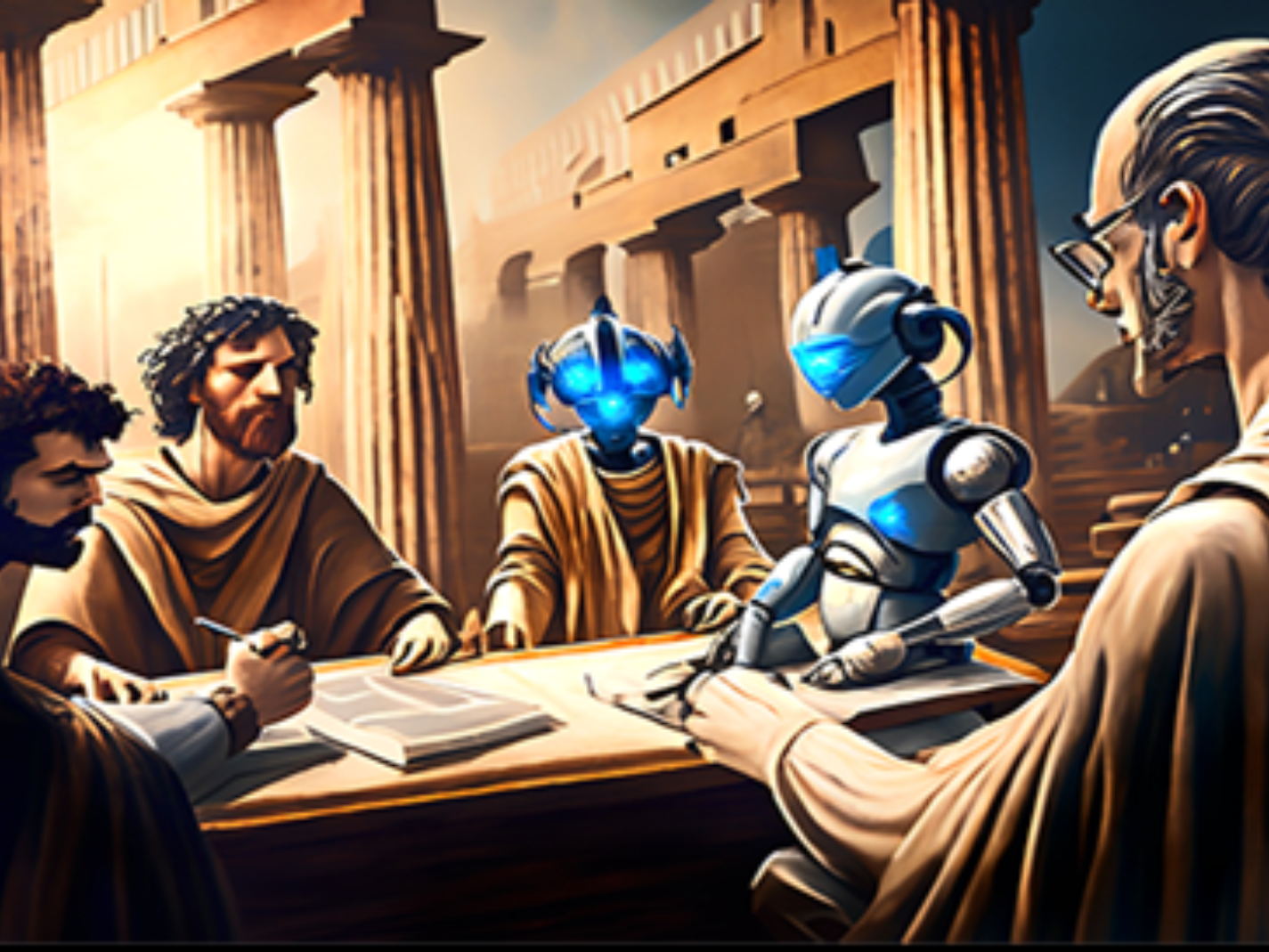
What are the important topics that make a university education valuable? And even while the student traverses the various courses? Or in the future, when the student takes his or her place in society?
I attended Columbia College in the 1960s. I took the foundational classes in Western Civilization and Humanities, but I failed to grasp much of their importance. When I took classes about single authors— Jonathan Swift and Arthur Schopenhauer—I began to appreciate how ideas could be configured into particular worldviews.
Now, if I were to design a course of study on important topics, I would engage a half-century of experience, thinking, writing, and artmaking when adding to the curricular recipe.
David Kane suggests reimagining the Great Books framework. The focus should be on “improving the student’s virtue,” whether conceived from a liberal or conservative perspective. Kane’s objective is to have students engage in fundamental questions:
All readings should address, either directly or indirectly, the fundamental questions: What is the good life? How can I live virtuously? What makes for a just society? Neither science, math, nor history belong in the required curriculum. Assign nothing written more recently than two centuries ago.
One comment by Anonymous argues for other aims, possibly adjacent to or possibly integral to Kane’s “cultivation of virtue.” Anonymous suggests that a serious education would include links—even math—“to a chain of discovery and intellectual work dating back to the beginning of civilization, and this is surely what most of us who hope to restore serious education want.”
I propose yet another aim.
Students should grapple with how technology augments our understanding of human nature, especially with the addition of generative artificial intelligence (AI). Without that understanding, we are trapped in virtue of one-hand clapping; that is, virtues standing alone overlook humanity’s concreteness.
Kane points us to fundamental questions: “What is the good life? How can I live virtuously? What makes for a just society?” Since we are not ants, elephants, nor any being other than human, the underlying question is, “What is it to be human?” Being human has been defined as a featherless biped, toolmaking, religious, poetic, suffering, hierarchical, and more. None of these suffice. The quest to discover who we are is an ongoing one.
One aspect of who we are is how we have imposed ourselves on each other and the natural environment. Imagine how we would define ourselves if our technology did not advance beyond termiting and making projectile points.
The advance of human technology—from warfare to architecture to agriculture to supply chains—drives and is driven by humanity. We define ourselves tautologically. Humans are what humans do, what humans believe, what humans value. We now find the expressions of humans being incorporated into large language models (LLMs) with extensive parameters and tokens and with imaginable speed. Thus far, these LLMs are tools like handheld calculators. Over time, with emergent capabilities, they may or may not become something other, something closer to approximating humans in terms of artificial general intelligence. They are becoming stand-ins as our agents.
AI agents are revolutionizing the way we interact with technology. Unlike traditional AI interactions where prompts are necessary for responses, AI agents operate independently, driven by goals rather than specific inputs. They’re autonomous problem solvers, seamlessly adapting to new information and environments, evolving with every task to achieve their objectives optimally.
This is a call to acknowledge the virtue of using technology—an applied virtue, where the ideas about a just and good life are entangled in the here and now. Without this approach, students may not see the value of those lasting virtues or disparage them as the discourse of cisheteropatriarchy.
To be sure, one needs to acknowledge the problems that attend LLMs, given the algorithms and tokenization that frame the bias of current AI models. Data selection, training, and mitigation techniques are part of the ongoing refinement of this technology.
The Legal Importance of Human Authorship
Where is the human in this new technology? How are we entangled with it? And how do we avoid a too-deep dependence on AI outputs? In effect, we are asking how a curriculum of applied AI technology can be understood as teaching a virtue beyond learning how to code and create prompts.
The Copyright Office is an important point of departure. Other points of departure might be the nature of creativity, the provenance of an artwork, curator decisions about aesthetics, commercial value, comparative cultural considerations, bias incorporated into the LLM model, whether others are exploited in the training of GAI models, and as a consumer-oriented, democratic approach to using images where copyright ownership is unimportant.
The protection given to individuals is found in the United States Constitution with the Copyright Act of 1790 that followed the British Statue of Anne (1710). Paintings and drawings were not mentioned until the Copyright Act of 1870. From the Act’s inception and through subsequent changes, the core meaning, as stated in the United States Constitution, Art. I, Section 8., was: “Congress shall have the Power . . . To promote the Progress of Science and useful Arts, by securing for limited Times to Authors and Inventors the exclusive Right to their respective Writings and Discoveries.”
More recently, the impact of new technology—photography, GAI—has clarified who the author of a work is and is not.
In Thaler v. Perlmutter (2023), Judge Beryl A. Howell observed that this particular claim for copyright presents only the question of whether a work generated autonomously by a computer system is eligible for copyright. In the absence of any human involvement in the creation of the work, the clear and straightforward answer given by the Register is no.
The question of “how much input is necessary to qualify the user of an AI system as an ‘author’ of a generated work” remained open.
It is worth noting that a person or an author refers only to humans inasmuch as only humans can apply for copyright, that copyright was intended to incentivize individuals to create new works while non-humans do not, and that in a 19th century Supreme Court decision about the copyrightability of photographs, the Court found it was the photographer, and not the camera, that “conceived of and designed the image and then used the camera to capture the image.”
This decision marginalizes GAI images, for better or worse. It adopts the Copyright Office’s determination. Both find the contested image lacking “human authorship.” Such works are categorized as unclaimable material. Other unclaimable material includes works older than the proscribed time limits for copyright, works in the public domain, or works belonging to others.
I think it is better to see these other factors as different from that of human authorship. Thus, these considerations do not revolve around the absence of human authorship.
Finding what is human in GAI output is at issue. It has become a fundamental question.
The Artist: Grappling with the GAI Interface
At this moment, GAI imagery travels along two paths. One path is about autonomously created images; the other is about collaborative images – human and GAI elements of varying degrees. How might we visualize these different paths ─ keeping in mind that the larger question is about answering what curricular is central to the fundamental questions of a university education.
Let us take a particular instance of this new technology, generative artificial intelligence (GAI) imagery. It has become a cornucopia of visual art, whether responding to human text prompts or as a collaborative part of the artist’s workflow.
In the following series of images (1 – 3), we can see the construction of a collaborative image. It is a hybrid of original art—photograph. painted image, sculptural, etc. —together with GAI output. The original photograph (1) would not be contested by the Copyright Office as having human authorship. The GAI computer-generated imagery (2A, 2B) would be denied copyright and considered excludable material. These images are composed with visual prompts in Stable Diffusion, with further postprocessing by the author in Adobe Photoshop. Whether postprocessing lifts the GAI images out of unclaimed material is outside the scope of this essay.
The Collaborative Approach
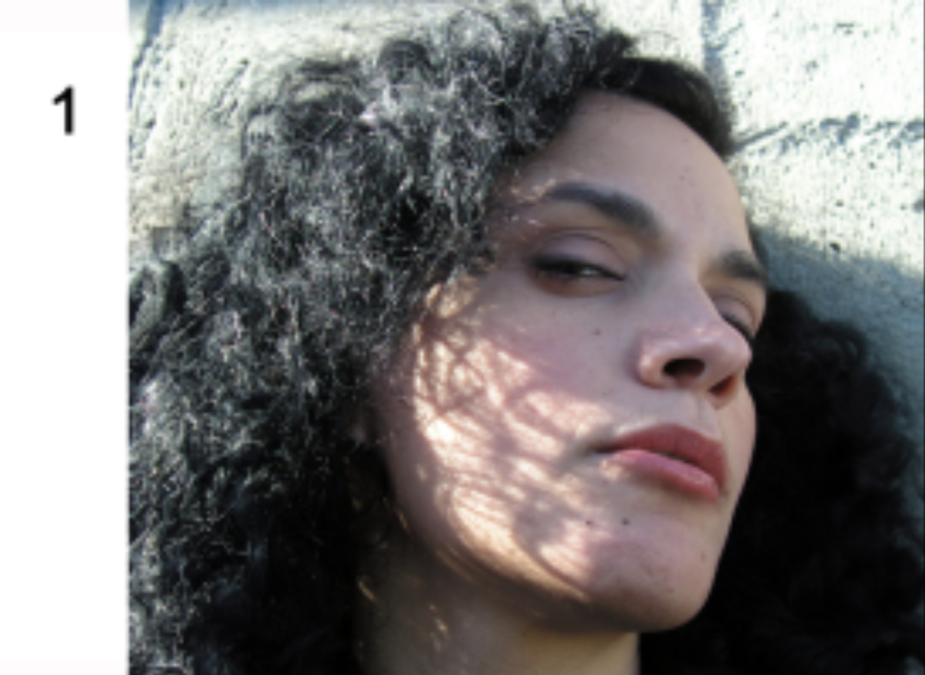
The original photograph without any GAI output. This image would be eligible for copyright.
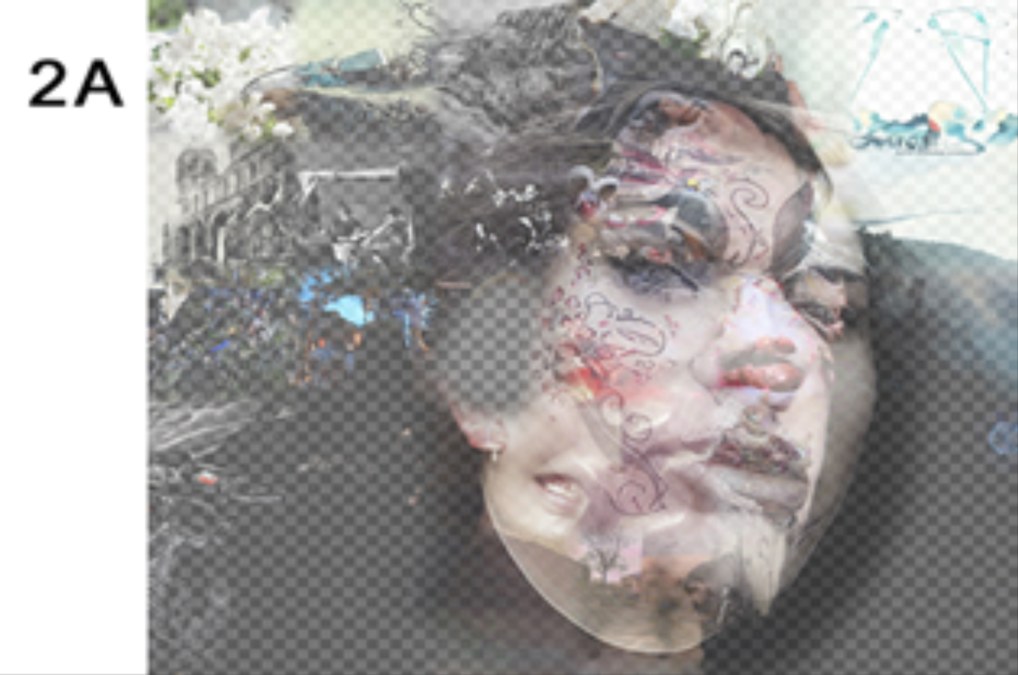
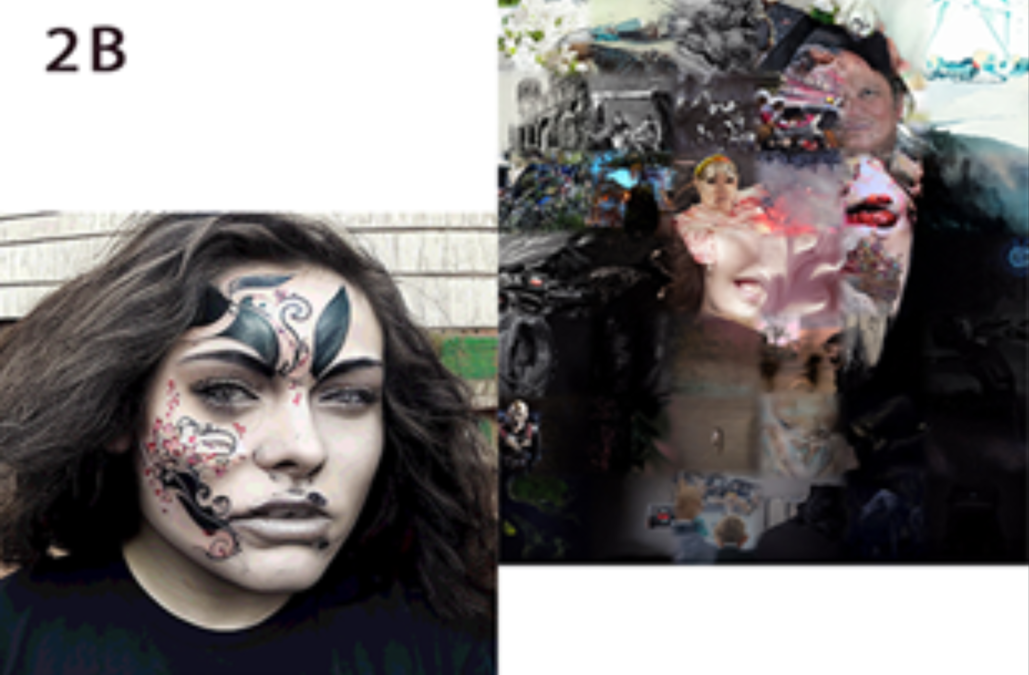
The GAI output (2A) was copied and pasted into Photoshop. When these images are seen on a computer monitor by themselves, they have varying degrees of opacity and effects. Subsequently, they can be blended or montaged (3) with the original photograph.
However, the initial GAI output (2B) from Stable Diffusion is at one hundred percent opacity. The decision is how to employ them as separate layers in the artist’s workflow. Thus far, even with these artist (human) decisions, the presence of GAI output seems to marginalize the granting of copyright or, at least, requires a case-by-case evaluation.
Using a photograph as a workaround would avoid questions of whether collaborative images require an evaluation. Why not simply photograph the image of one’s own collaborative work on a computer monitor? That photograph would automatically be granted copyright since photographs are copyrightable. A photograph of the collaborative image would be eligible for copyright under existing rules. To be sure, this is an extra step and may not identically replicate the original collaborative image, but for many artists, being good enough is sufficient.
The photograph of the original art may be challenged as a copyright workaround under the Bridgeman Art Library, Ltd. v. Corel Corp opinion. The question is whether the photograph adds any original elements or is a mere copy. Having new original elements would support copyright, but being a mere copy would not. There are likely alternative legal theories and technical changes to advance copyright despite Bridgeman: (A) the artist, as a photographer, can add elements such as lighting, contrast, and the like that add to the underlying composition that has generative AI elements; (B) the artist can further differentiate the photograph from the underlying composition with additional post-processing; (C) as distinct from Bridgeman, this case proffers the original art and the photograph of it by the same person rather than by a reproduction company making copies of another artist’s work and, further, the artist would have less pecuniary interest in the replica while that is central to the motive of the reproduction company.
David Salle, a noted painter currently experimenting with GAI images, has explained this blended approach at the Whitney by painting over his GAI images that echoed his own pastoral series.
Parenthetically, it is unlikely that the GAI element, standing alone, would be used by others as part of their workflow; given that unlikelihood, copyrighting the final image and excluding the GAI elements might satisfy the artist, the copyright office, and the public with a compromise appreciation of such works.
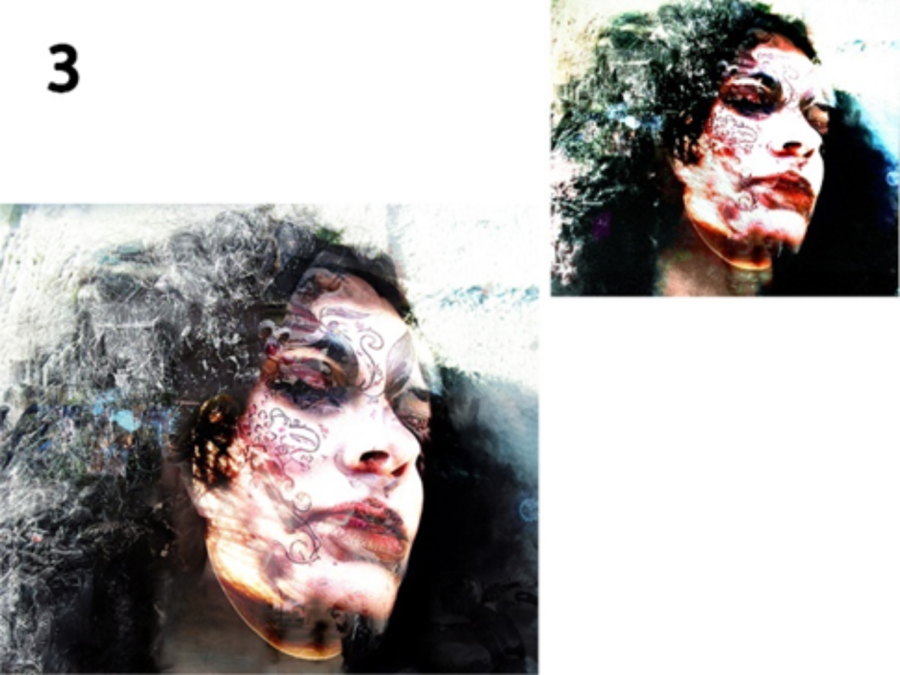
Two versions of a collaborative image The Real Me. (A) Original photograph and GAI output using Stable Diffusion (LL). (B) The same image is rendered as a photograph of version (A) taken from the computer monitor on which (A) was created (UR).
The Generative AI Approach (absent human authorship)
The concern in news media, as well as in university classes, is that LLMs will substitute for actual human—student—involvement. Perhaps there will be postprocessing or a limited use of chatbots as study partners. However, the fear is about degrading literacy or avoiding educational risks with overreliance on this technology.
On the other side of these concerns, there is the allure of GAI images.
A text prompt (4) in Labs.Google image generator yields a variety of visual interpretations. This initial input conveys the criticism of “these are not your pixels.” The question is whether using multiple platforms—taking the Labs.Google image (4 UR), creating additional images from it in Stable Diffusion, and then integrating these several images (as processed in the collaborative image above, 5)—still might not satisfy current requirements to qualify for copyright, but might satisfy commercial, fine art, and social media interests.
The latter interests could be understood as the democratization of image use. True, democratization would lead to a consumer mob mindset, but these are the choices confronting most applications of human technology.
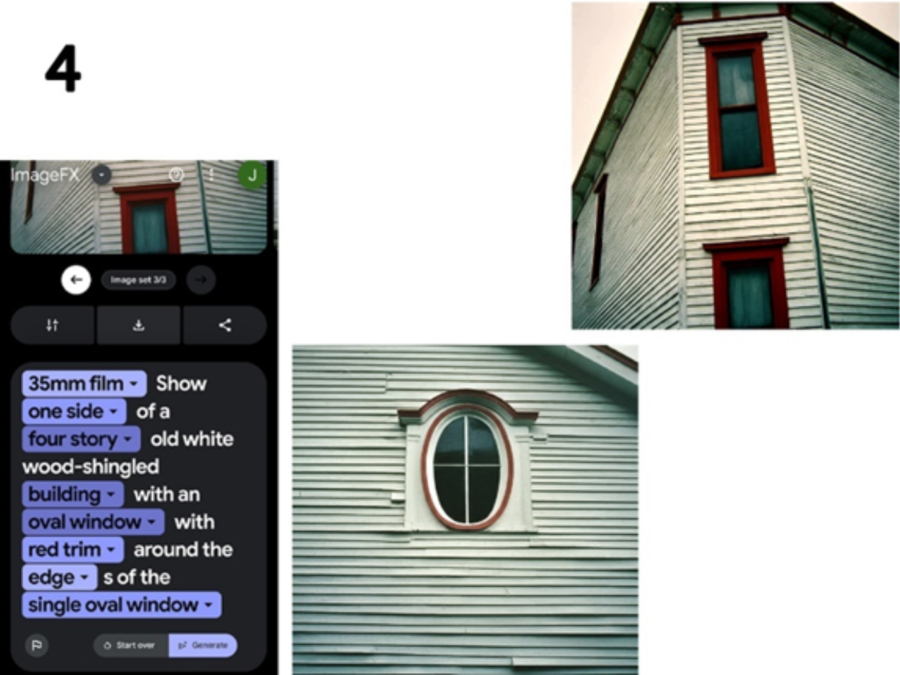
A text prompt in Labs.Google (ImageFX) and two of the images that responded to the prompt.

The Withering of the Anthropocene (above) was composed of several different GAI images without non-excludable material, such as a photograph. It was part of an art exhibit at the Escondido Arts Partnership (Anthropocene).
Reflection
I admit that many, including Kane, would take issue with placing what appears to be a technical skill to be part of a curriculum that focuses on fundamental questions.
If our goal is virtue, then we need to focus on virtue. Studying geometry [technology, GAI] does not make you a better person. It does not help you determine the future you want to have. It does not generate answers to the fundamental questions. Euclid [nor chatbots or GAI image platforms do] not lead to an examined life.
Rather than take issue with Kane, I suggest a discussion around curricula that focuses on fundamental questions.
Benjamin Franklin proposed an academy in 1749 that later evolved into the University of Pennsylvania. His proposal focused on what should have been essential learning in pre-Colonial times. The educational foundation not only leads to individual happiness but also qualifies the next generation to lead.
The good Education of Youth has been esteemed by wise Men in all Ages, as the surest Foundation of the Happiness both of private Families and of Common-wealths. Almost all Governments have therefore made it a principal Object of their Attention, to establish and endow with proper Revenues, such Seminaries of Learning, as might supply the succeeding Age with Men qualified to serve the Publick with Honour to themselves, and to their Country.
As one reads through the proposal, the impression is not in the goal of teaching of virtue to students, but an integration of practicality with virtue. Franklin quotes John Locke in footnote 10 with this educational approach.
I would therefore advise all Gentlemen to learn perfectly Merchants Accounts; and not to think ’tis a Skill that belongs not to them, because it has received its Name, and has been chiefly practis’d by Men of Traffick.
Not only the Skill, but the Habit of keeping Accounts, should be acquir’d by all, as being necessary to all.
Locke’s writings are often considered in discussions about liberty. However, in a discussion about studies that lead to virtue, I read both Franklin and his Locke quote as avoiding condescension to the skills and habits of mind practiced outside the academy or what might have been seen in that historical moment as practiced by those of the lower class.
Or what we might infer from a Sanskrit proverb: “even in heaven there are ants.”
Kane argues that neither the study of geometry nor Euclid leads to becoming a better person or to an examined life. But isn’t that a view of heaven in which there are no ants? We need not anchor this discussion in anthropocentrism where humans see the world, and heaven, in human terms, but simply one of hubris in cultivating virtue without technology.
I have in mind Aldous Huxley’s revisiting the premise of Brave New World (1932) thirty years later in his last novel, Island (1962). Huxley reconceptualizes the good society, its premises and how it can be achieved. The former is a dystopia, the latter is a utopia. Putting aside the psychopharmacological role of soma and moksha—with the former being one of population control, the latter being one of enlightenment—Huxley asks us to reimagine how the good life is put together. Island blends western science and technology with Mahayana Buddhism, focused on the appreciation of the here and now. We do not find cloning technology that removes natural birthing and self-knowledge is one of amusement.
Like Huxley, should we reconceptualize a curricula that incorporates technology alongside the virtues of the good life? Where GAI is part of that examination of life inasmuch as its construction is an extension of human attempts to comprehend and manage life circumstances?
Of course, as with any curricula, there are the uses and abuses of knowledge. Despite that realization, Franklin, Kane, and many others still want to tinker with formula to structure an education of virtue.
Image by Joe Nalven
I like your comment, “Now, if I were to design a course of study on important topics, I would engage a half-century of experience, thinking, writing, and artmaking when adding to the curricular recipe.”
I agree with this holistic approach … emphasizing the organic or functional relation between parts and the whole … and I prefer “awareness” over “acquiring/having virtue”.
You have left my head spinning. It will take at least a week for me to absorb all the elements you raise in this post. I’m going to keep it around and break it into its components as I understand them to see how they come together.